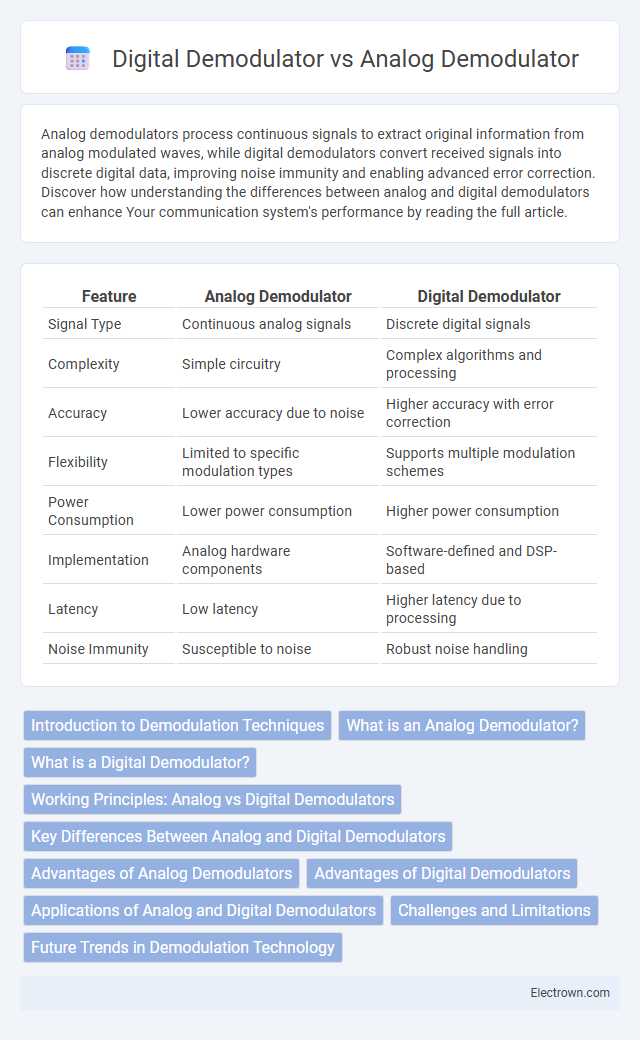Analog demodulators process continuous signals to extract original information from analog modulated waves, while digital demodulators convert received signals into discrete digital data, improving noise immunity and enabling advanced error correction. Discover how understanding the differences between analog and digital demodulators can enhance Your communication system's performance by reading the full article.
Table of Comparison
| Feature | Analog Demodulator | Digital Demodulator |
|---|---|---|
| Signal Type | Continuous analog signals | Discrete digital signals |
| Complexity | Simple circuitry | Complex algorithms and processing |
| Accuracy | Lower accuracy due to noise | Higher accuracy with error correction |
| Flexibility | Limited to specific modulation types | Supports multiple modulation schemes |
| Power Consumption | Lower power consumption | Higher power consumption |
| Implementation | Analog hardware components | Software-defined and DSP-based |
| Latency | Low latency | Higher latency due to processing |
| Noise Immunity | Susceptible to noise | Robust noise handling |
Introduction to Demodulation Techniques
Demodulation techniques are essential for extracting original information from modulated carrier signals in communication systems, with analog demodulators designed to process continuous waveforms and digital demodulators tailored for discrete digital signals. Analog demodulation methods, such as AM and FM demodulators, focus on recovering analog audio or video signals, while digital demodulators implement algorithms like Phase-Locked Loop (PLL) and Maximum Likelihood Sequence Estimation (MLSE) to decode data encoded in digital formats like QAM or PSK. The choice between analog and digital demodulation depends on the signal type, required accuracy, and application context, impacting signal quality and system complexity.
What is an Analog Demodulator?
An analog demodulator extracts original information from analog carrier signals by reversing modulation processes like amplitude or frequency modulation. It converts continuous waveform signals into usable analog output, essential in traditional radio and audio systems. Understanding your communication needs helps determine whether an analog demodulator or a digital demodulator is more suitable for preserving signal integrity and quality.
What is a Digital Demodulator?
A digital demodulator processes digitized signals to extract information from modulated carriers using algorithms and digital signal processing techniques, enhancing noise immunity and accuracy compared to analog demodulators. Unlike analog demodulators, which rely on hardware components like filters and detectors, digital demodulators convert incoming signals into digital form, enabling more flexible and programmable demodulation methods such as QAM, PSK, and FSK. Digital demodulation improves performance in complex communication systems, supporting higher data rates and robust error correction.
Working Principles: Analog vs Digital Demodulators
Analog demodulators extract information by directly processing the continuous modulation variations of the carrier signal, such as amplitude or frequency changes, using circuits like envelope detectors or phase-locked loops. Digital demodulators convert the received analog signal into digital form and apply algorithms like coherent or non-coherent detection to recover data, enabling improved noise immunity and advanced error correction. The key difference lies in analog demodulation relying on hardware-based signal extraction, while digital demodulation leverages signal processing techniques for higher accuracy and flexibility.
Key Differences Between Analog and Digital Demodulators
Analog demodulators extract information from continuous wave signals using techniques such as envelope detection or synchronous detection, suited for AM and FM analog broadcasts. Digital demodulators process discrete sampled signals, employing algorithms like phase-locked loops and error correction to recover data in digital communication systems including QAM and PSK. The primary differences lie in signal representation, processing methods, noise immunity, and compatibility with modern digital protocols, where digital demodulators offer enhanced accuracy and flexibility over analog counterparts.
Advantages of Analog Demodulators
Analog demodulators excel in simplicity and low power consumption, making them ideal for cost-sensitive and battery-operated applications. They offer real-time signal processing with minimal latency, crucial for certain communication systems requiring immediate response. Their robustness to hardware imperfections and straightforward implementation enhance reliability in noisy or varying analog environments.
Advantages of Digital Demodulators
Digital demodulators offer superior noise immunity, enabling clearer signal recovery in adverse conditions compared to analog demodulators. They provide greater flexibility through software-based modulation schemes, allowing easy updates and adaptation to various communication standards. Furthermore, digital demodulators support advanced error correction techniques, enhancing data integrity and overall system performance.
Applications of Analog and Digital Demodulators
Analog demodulators are widely applied in traditional AM and FM radio receivers, where they extract audio signals from continuous waveform modulations for broadcast and communication systems. Digital demodulators are essential in modern wireless communications, including cellular networks, satellite transmissions, and digital television, providing robust data recovery from complex digital modulation schemes like QAM and PSK. The choice between analog and digital demodulators depends on factors such as signal type, bandwidth efficiency, noise performance, and the specific requirements of applications like mobile communication, broadcasting, or data transmission.
Challenges and Limitations
Analog demodulators face challenges such as limited accuracy and susceptibility to noise and distortion, leading to degraded signal quality in complex communication environments. Digital demodulators, while offering improved precision and robustness against interference, require higher computational power and face latency issues, especially in real-time applications. Both types struggle with bandwidth constraints and multipath fading, complicating reliable signal recovery in wireless systems.
Future Trends in Demodulation Technology
Future trends in demodulation technology emphasize the shift from traditional analog demodulators to advanced digital demodulators due to their superior accuracy, noise immunity, and flexibility in handling complex modulation schemes. Digital demodulators leverage machine learning algorithms and software-defined radio (SDR) platforms, enabling real-time adaptation to varying signal environments. Your communication systems will benefit from improved performance and scalability as digital demodulation becomes the standard in next-generation wireless technologies.
analog demodulator vs digital demodulator Infographic

 electrown.com
electrown.com